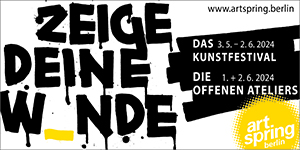Article by Celia Wickham // July 6, 2018
Marcela E. Torres is a Chicago-based artist and educator originating from Salt Lake City, Utah, and a recent graduate of the School of the Art Institute of Chicago. Having been brought up within the Mormon faith of Latter-day Saints, Torres’s work has become rooted in redefining and infiltrating ideological spaces of control. As the artist looks to challenge and renegotiate systems of power and race, Torres makes use of structure and ritual as places of transformation and resurgence. Through their performance and body-based work, focusing specifically on martial arts and self-defense, Marcela’s practice exists within a space of discipline, where new understandings of the self and the other can be re-determined, understood and shared.
I visited Torres in her apartment and home studio in Chicago’s Pilsen neighborhood, where we spoke about ritual-making as both a form of art and a practice of living, and the interdisciplinary nature of their work, from community-based workshops to gallery performances and programming. No matter the context in which the work exists, Torres’s practice redefines and exemplifies the freedoms and catharsis that can come from the creation of self-determined systems of structure and control.
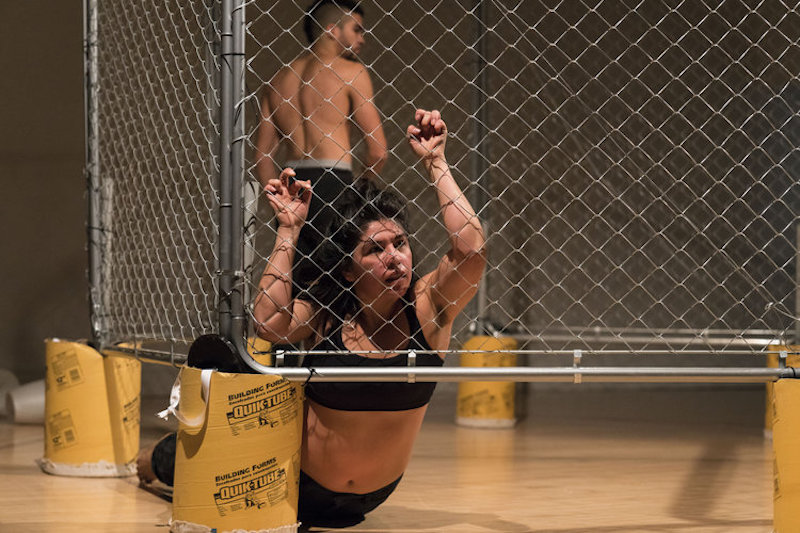
Marcela E. Torres: No Contest, 2017, with Chase Calloway // Courtesy of the artist, photo by SAIC Media Resources
Celia Wickham: Where do you feel your art making practice began?
Marcela E. Torres: I knew that I wanted to be an artist from a really young age. My eldest sister is a wonderful drawer and painter, so I was always trying to compete with her in some way to prove who the real artist was. We went about our art making in very different ways. I was interested in approaching art making from a perspective that was more conceptually based, so when I started my undergraduate degree when I was 25, I chose to do sculpture because I thought it would provide the most lenience. I knew I wanted to involve physicality in my work.
To me making art has always been very strategic. I worked out a lot during undergrad and realized the thing that was inherent and specific to me and my experience was the fact that I had my own body. By using my head, I could use my body as a tool that could transcend the object. During that time I also got really into Olympic weightlifting and knew that I could put these two things together, and that’s how I started doing performance.
CW: Did you have people who supported you during that shift from sculpture to performance?
MT: I had mentors during undergrad in Utah, but it was really hard because no one really understood my point of view. I would say things like, “Wouldn’t it be interesting if I trained and fought a bunch of people?” They would reply, “No because you’d always loose,” and I just didn’t understand. “A guy is always going to beat a woman,” they’d say, even when I’d bring up things like technical skill. I started to ask myself the question: What does it mean to win? The work developed further when I got to the School of the Art Institute of Chicago, where I knew that I wanted it to be race-based and use fighting. It was super interesting to come here and have people think about my work as displaying interpersonal relationships and exploring how we’re able to communicate hurt or violence through our bodies to an audience.
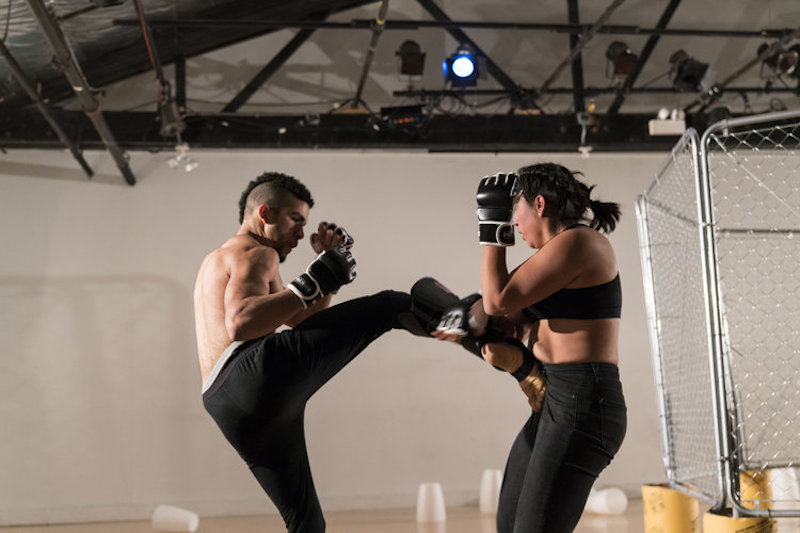
Marcela E. Torres: No Contest, 2017, with Chase Calloway // Courtesy of the artist, photo by SAIC Media Resources
CW: Could you talk a bit more about strategy in relation to your work?
MT: When I think about my skills, I’m really good with communities, using my body and making things legible, and I have a pretty good aesthetic eye. I love fighting, but I also chose to do it as a strategic move, where it enabled me to say things that were difficult. Fighting became a way in which I can talk to straight white guys who don’t like art in a much more accessible way. The fights themselves can also become objects, whether it’s a photograph or performance ephemera. I use the word “strategic” in the way that I chose this specific language to talk about something that’s difficult and to include new audiences in the conversation. I’m always asking myself, “What is the byproduct, who’s going to see it, how is this different, how is it consumable for others?”
CW: Do you think you’ve always made work in this way?
MT: I’ve always made work like that, but it has a lot to do with resilience. As a youth I would code switch a lot to make sure people liked me, so that I could get rides home from school or to get into a summer program. Another way of talking about being strategical is that I’m a hustler. As a kid, if your parents can’t afford to do these things for you then how are you going to get those things? So you have to be a hustler, you have to strategize. You learn how to locate yourself in a specific way so that people can help you if you can’t do it by yourself. This is a natural thing I’ve done forever. Sometimes people don’t understand that my background—growing up in an extremely religious white space—translates into my work. I’m interested in the spaces we can infiltrate and the hustler things we can do to get the things we need; and maybe those things are love and care.
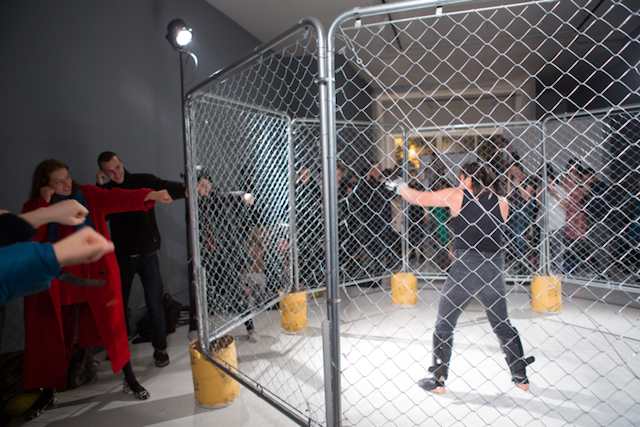
Marcela Torres: No Contest, 2017, with Chase Calloway // Courtesy of the artist, photo by SAIC Media Resources
CW: I think coming from more extreme religious communities affects people later on in their artistic practices. Would you say so?
MT: I completely agree. It influences the way you make and why you make. One friend of mine loves to throw parties, and I think a big part of it is that it was against the religion they grew up with to have parties and celebrations. It’s interesting to think about their strategizing to have those events occur. I don’t see my former religion to be a bad thing because it taught me a lot, like the importance of resilience. I don’t know what it’s like to not be hustling, to not be strategizing. The idea of hustling can come off as negative for a lot of people, like you don’t care about others, but it’s about doing it ethically as well.
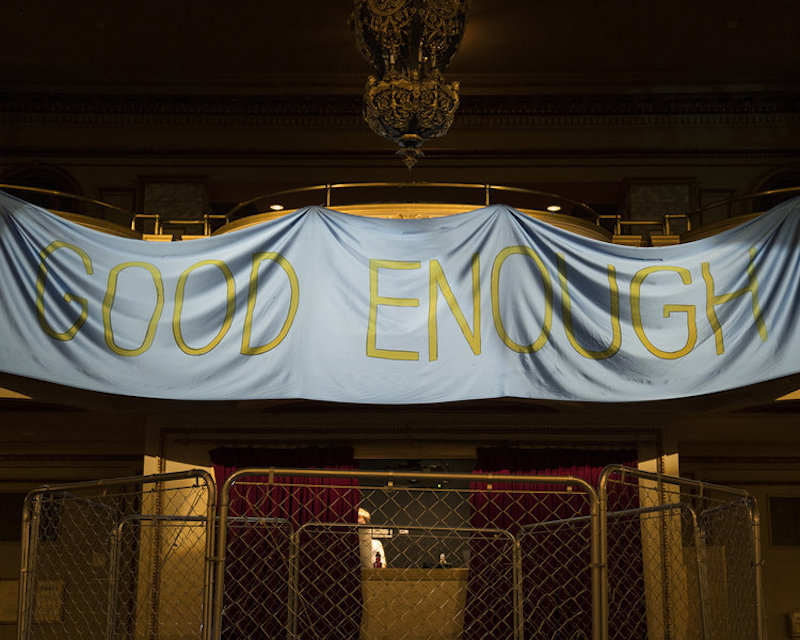
Marcela Torres: Good Enough Banner, 2017 // Courtesy of the artist, photo by Emerson Granillo
CW: A lot of that self-determination spills out into your work, even in the structures you make for yourself, such as training in the gym for months when working on a piece.
MT: In my religion people live within certain regulations, and the regulations aren’t just, “You’ll get in trouble,” or, “You’ll get expelled from school.” It’s more, “You won’t get to live with your family for eternity,” or if you wear a sleeveless shirt you are therefore a terrible person. That’s always being held over you and you leave those kinds of religions it takes a long time to reframe your brain and learn to trust yourself. Within my work it’s about seeing a structure and then trying to put in a new vocabulary or trying to infiltrate that structure. You get to decide whether the structure is important to you or not. You get to develop your own code of ethics and controls that become the determining factors. In some ways you have to get used to the idea that maybe you won’t see your family for eternity, but you have to let go of the things that guilt you into control.
CW: How did you approach this, how did you “let go”?
MT: Having routines and regimes is really important to me. When I first left my religion I realized I had to find new rituals. In the same way that people find strength and happiness through religion, working out became that for me. Watching your body change, getting physical muscles and knowing that you caused it—I got really obsessed with that. Sometimes I feel like I’m a nihilist, because you have to choose your priorities, what really matters. When I came to SAIC I was trying to learn a new technical practice, Muay-Thai, which is Thai kickboxing and what MMA is based upon, and with any of these things there has to be a certain level of discipline. Controls of religion can transform into other forms of discipline and modes of thinking. Although it doesn’t control me the same way, it’s all about finding a new language to make things legible, which then needs to be articulated in a new technical skill.
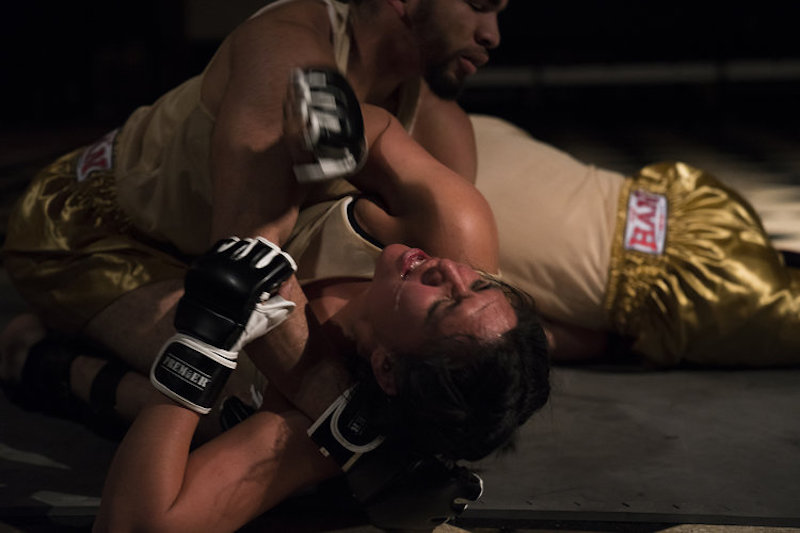
Marcela E. Torres: Favored to Win, 2017, with Chase Calloway and Jesse Meredith // Courtesy of the artist, photo by Emerson Granillo
CW: You’ve spoken a lot about self-defense in the past, both in relation to your art practice and your everyday life. What are the crossovers that you think occur?
MT: I think of my art practice as me, as my body. It’s the reason why I’ve come out with the things that I have, in that they have been based on figuring out methods to feel value in myself, to build strength, to talk about microaggressions. All of my work becomes a tool to help myself; I don’t know if I’d be able to make anything if it wasn’t based in what I need, but I always hope other people can gain from it.
I think of self-defense as protecting yourself from any attacker, which could mean yourself. Thinking about mental health, it could be anxieties or insecurities. It’s about how you locate yourself, catching those moments and looking at them. In my self-defense classes, I want to provide these moments where we can support each other and develop tools to feel good enough. Having other people there to give you care reminds you that you’re worth being cared for. It’s a form of self-preservation, and in that way my art’s a little selfish. It is for me, but then I develop it to share. The two are intertwined. A lot of the self-defense I did before was in relation to racism and unsafe feelings during Trump’s first year as president, whereas now the self-defense I’m doing is about self-awareness and police tactics, and modes of escalation and de-escalation.
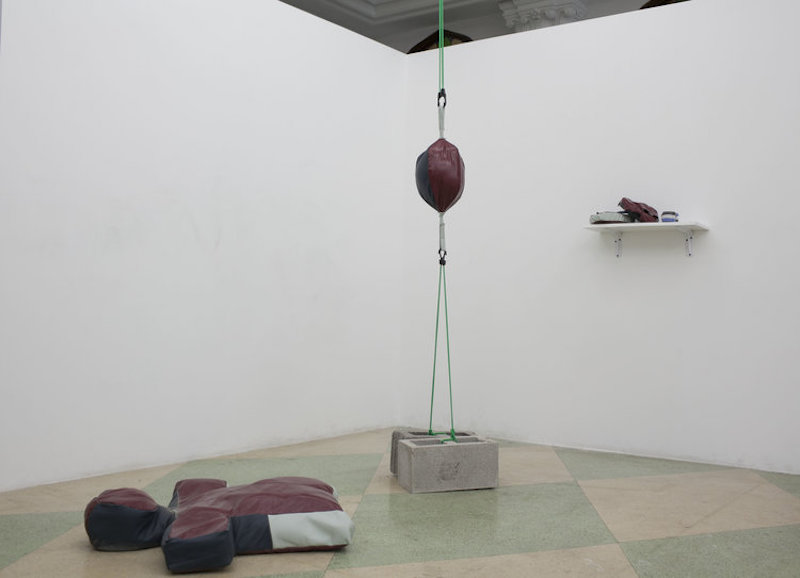
Marcela E. Torres: ‘Bruising,’ 2018 // Courtesy of the artist, photo by Nate Acre
CW: It’s interesting to think about the ways in which your work has developed and expanded from more of a context of being in art school, to it existing in a broader community within Chicago. How has that been?
MT: I’m working with an expansive model, so it’s not just the performance; it’s the workshop, the book, the artifacts, providing multiple forms of access. Community work is extremely important to me. We complain about Chicago being segregated but we never actually go into those other areas, so it’s become important to me to teach in the South Side or West Side neighborhoods, to have other people activating my work. But with that, there’s always a struggle of not knowing how to place myself within a gallery sphere. I feel like people don’t see me that way, but I see myself that way, I see myself being able to transcend any space. I see that as my next challenge. Sometimes people are put in certain boxes, but I don’t want to be; I want to be able to do everything.
This article is part of our monthly topic of ‘Control’. To read more from this topic, click here.



